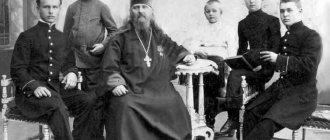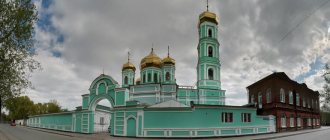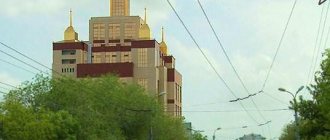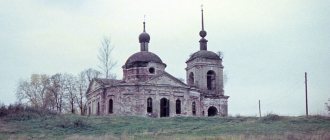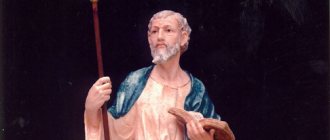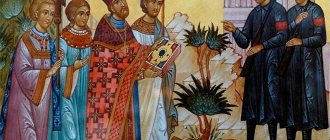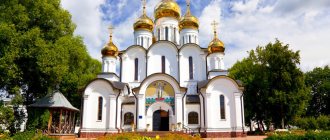Reverence
On January 17, 1999, Archbishop Andronik (Nikolsky) was canonized as a locally venerated saint of the Perm diocese. Canonized as holy new martyrs and confessors of Russia at the Bishops' Council of the Russian Orthodox Church in 2000 for church-wide veneration. On the icon of the Council of New Martyrs and Confessors, painted at that time, the martyrdom of Saint Andronicus was depicted in the upper left part of the fourth mark.
Hegumen Damascene (Orlovsky) writes:
“At the precipice of the thousand-year Christian history of Russia, an ascetic and missionary archpastor, similar to Saint Stephen of Perm, ascended to the Perm See. His life was a model of ancient piety. He was an ascetic, a man of prayer and a non-acquisitive man, who considered all material well-being and wealth as nothing. The bishop donated all his funds to help the poor. He dressed simply, never wearing silk cassocks; and although he was awarded many orders, he never wore decorations. The saint was a zealous follower of monastic rules and church rituals. He fasted strictly: on fast days he ate only vegetables, on fast days he made do with a small amount of food, and in the last days of Holy Week he ate only prosphora and tea. On the eve of the day when he was supposed to celebrate the liturgy, the bishop hardly slept, standing in prayer all night.”
.
Bishop - about the people
Despite his poor health, the bishop traveled a lot around the diocese, along its terrible off-road conditions. He served in quiet rural churches. In every village and hamlet where he stopped, he met with people, listened, answered questions, which took at least six hours every day, including services. The peasants, who had never been near the bishop, were curious to see and listen.
And the bishop looked, and although he believed in the “God-bearing Russian people”, which they sometimes reproached him with, accusing him of chauvinism, he saw in him more than just glory and “piety”.
“There is now a common complaint about popular drunkenness, about the revelry of especially young people, the decline of family morals, dandyism, dishonesty, mischief and hooliganism, vindictiveness and cruelty, treachery and deceit to the point of perjury under oath, which already speaks of the loss of faith itself, for the believer is afraid to violate oath.
The younger generation and even children are growing up without any rules of life: a kind of spiritual savagery is imprinted on their faces. And what will happen to them later, when cruel life itself leaves its merciless imprint on them, especially if we take into account the pursuit of material, or better yet, animal contentment, which has become a characteristic feature and spirit of recent times?
These are all more than bleak, ominous signs, at the sight of which one becomes terrified for the future of our people’s life.”
Essays
- “Ancient Church teaching on the Eucharist as a Sacrifice in connection with the question of Atonement” (1895, candidate’s essay)
- Missionary path to Japan. Kaz., 1899;
- Christ the Redeemer according to the teachings of St. Fathers of the Church // PS. 1902. No. 9;
- Missionary year in Japan. From the diary of a Japanese missionary. Ufa, 1904.
- What to wish for our theological school. Ufa, 1905;
- The Russian civil system of life before the court of a Christian, or the Foundations and meaning of the Tsarist autocracy. Art. Russa, 1909;
- Conversations about the “Union of the Russian People”. Art. Russa, 1909;
- Reflections of a bishop returning from a trip around the diocese. M., 1913;
- Come to the beginning of the service // Omsk EV. 1913. No. 18. P. 18-31;
- Christian rule of life for universal happiness // Ibid. No. 21. P. 16-20;
- Word at the opening of missionary courses // Ibid. 1914. No. 14. P. 36-39;
- Letters from the bishop to the priests. Perm, 1915;
- Our church and people's life, as it is: (Reflections of a bishop after traveling around the diocese). Perm, 1916;
- About the Church, about Russia: Words, 1898-1918 / Comp. V. Korolev. Fryazino, 1997.
- I write from the abundance of a grieving heart. Series of Letters on Spiritual Life. M. Sretensky Monastery. 2007 303s.
- Sermons, addresses, messages. Tver: Bulat, 2004. 465 p.
ANDRONIK
(Nikolsky Vladimir Aleksandrovich; 08/1/1870, village of Povodnevo, Myshkinsky district, Yaroslavl province - 06/20/1918, Perm), schmch. (memorial on June 7, in the Cathedral of New Martyrs and Confessors of the Russian Church, in the Cathedral of New Martyrs and Confessors of Radonezh, in the Cathedral of Fathers of the Local Council of the Russian Church 1917-1918, in the Cathedral of Saints of the Perm Metropolis, in the Cathedral of St. Petersburg Saints and in Rostov-on-Don Yaroslavl Saints), Archbishop. Perm and Kungur. Genus. in the family of the psalm-reader of the Preobrazhenskaya Church. With. Povodneva. In 1885 he graduated from the Uglich Secondary School, in 1891 from the Yaroslavl Secondary School, in the same year he entered the MDA, from which he graduated in 1895 with a Ph.D. theology for op. "Ancient Church teaching on the Eucharist as a sacrifice in connection with the question of atonement." Aug 1 1893 tonsured a monk with the name A., Aug. 6. 1893 ordained a hierodeacon, July 22, 1895 - a hieromonk. In 1895 he was appointed assistant inspector of the Kutaisi DS, in Aug. next year - teacher of homiletics at the Alexander Missionary School in Ardon in the North. Caucasus, then her inspector. The seminary had high authority among Ossetian peasants; in 1896, there were many times more people who wanted to study there than it could accept. On March 20, 1897, by the determination of the Holy Synod “for diligent and useful service in the seminary and frequent preaching of the word of God,” A. was elevated to the rank of cathedral hieromonk of the Don Icon of the Mother of God of the Moscow monastery. On Sept. 1897 appointed missionary to Japan.
Sschmch. Andronik (Nikolsky), archbishop. Perm Sschmch. Andronik (Nikolsky), archbishop. Permian
Traveling to Japan through Italy, Greece and the North. America together with Archimandrite. Sergius (Stragorodsky; later Patriarch of Moscow and All Rus'), also appointed to the mission, A. became acquainted with modern. the state of Christianity - Catholicism and Orthodoxy, visited the ancient Christ. shrines - catacombs and tombs of martyrs, ruins of the Colosseum. A. after. wrote that prayer at places consecrated by the blood of the first Christian martyrs inspired him and Archimandrite. Sergius for the ascetic service of the Church - to make sure that “the church beginning of life is a holy and complete beginning for all of us.”
Upon his arrival in Japan, A. became closely acquainted with the life of Orthodox Christians. communities Few Japanese the flock, professing Christianity among millions of pagans, struck A. with the simplicity and depth of faith. Afterwards A., recalling the year he spent in Japan, admitted that serving among such people was great happiness for him. Intense activity led to health problems, and in 1899 A. returned to the Aleksandrovskaya DS. Upon his elevation to the rank of archimandrite on March 5, 1899, A. was appointed rector of the seminary. On May 6, 1901 he was awarded the Order of St. Anna 2nd degree. Oct 18 1901 at the request of Bishop. Ufa Anthony (Khrapovitsky) A. was transferred as rector to the Ufa DS, in 1902 he became dean of the Mont-Rei diocese. In May 1905, for services to the education of youth, he was awarded the Order of St. Vladimir 4th degree.
Oct 13 1906 A. was consecrated Bishop of Kyoto and appointed assistant to St. equal to Nicholas (Kasatkin), archbishop. Japanese. Arriving in Osaka, A. found Orthodox Church. the community is in a deplorable state. No more than 10 people visited the temple; one psalm-reader read and sang on the choir. A. began his ministry by visiting the homes of parishioners every weekday evening, getting to know their families, talking, preaching, and learning their needs. During A.'s service in Japan, the number of people visiting the temple increased significantly, and a large mixed choir sang at services. Once again, missionary work in an unfavorable climate for A. led to deterioration in health. On July 5, 1907, the Holy Synod granted him leave.
From Nov. 1907 to March 14, 1908 A. temporarily ruled the Kholm diocese in the absence of someone elected to the State. Duma Archbishop Eulogius (Georgievsky), then was appointed Bishop of Tikhvin, vicar of the Novgorod diocese. I visited all the churches that are part of the Tikhvin region in September alone. 1908 visited 22 rural churches in Krestetsky, Borovichi and Valdai districts, served, preached and talked with people. On March 8, 1913, A. was transferred to the Omsk and Pavlodar departments. In Omsk he organized missionary courses for the clergy 3 Siberia. dioceses. He convinced the clergy of the need for clergy to travel to villages located far from churches to perform confession and Communion.
13 Apr 1914 A. was transferred to the Perm department. The years of A.'s ministry became a time of growth in church life in the diocese. Several were built. temples, including the majestic cathedral of the Belogorsk Monastery; the bishop regularly toured the churches of the diocese. lectures, conversations, meetings of clergy and laity were organized; Missionary and folk singing classes began in the auditorium at the Stefanovskaya Chapel in Perm. circles; a good diocesan library was assembled. Akathists were served in all churches in Perm, at the end of which conversations were held. At one of the churches, a guardianship for the poor was organized, which had its own canteen, where lunches were given out at a cheap price to everyone who wanted them, and for those in need - free of charge. Bookstores opened at the candle factory and in the courtyard of the Belogorsk Monastery. An orphanage was set up at the church for the blind. Voskresenskaya c. maintained an almshouse at her own expense, in which they lived approx. 50 elderly. At the cathedral, a society of banner bearers was organized, numbering several. dozens of people, in 1917 a squad was created to protect the cathedral and the bishop's house.
In the book. “Letters from a Bishop to Priests” A. advised the pastors of the Perm diocese not to limit themselves to divine services in churches, but also to serve in remote villages, “so that everyone has the opportunity to pray. Depending on local conditions, you can hold a vigil in one village in the evening, and another vigil and mass in the village in the morning. In the evening, go to another village and perform vespers or an akathist there with a conversation.” A. recommended that parish priests introduce nationwide singing in churches, starting with well-known prayers, striving to ensure that all liturgical chants, together with the canonarch, are sung by the parishioners themselves. “In this way, church chants will come into life... and now they will supplant all the dirty worldly songs that have proliferated among the people; They will also teach reverence in behavior itself.” A. advised pastors not to limit themselves to preaching during the liturgy, but also to preach during other services, to organize liturgical readings and conversations in churches and schools with choral performance of spiritual chants. A. attached great importance to circles of zealots of piety, in which he saw assistants to shepherds in Christ. education of the people, organized pilgrimages to holy places.
A. dressed simply, never wore silk cassocks or orders, with which he was awarded, and distributed all personal funds to the poor. On the eve of the day of the liturgy, he spent almost the entire night in prayer.
Taking care of missionary activity among the Old Believers (see Old Believers), A. contributed to the organization in the Perm province. Edinoverie parishes (see Edinoverie). Since, due to a lack of pastors, many Edinoverie parishes were left without priests for a long time, through the efforts of A., pastoral courses were established in Perm for the training of Edinoverie clergy. The training ended with a solemn service; the liturgy in the Edinoverie church was performed according to the 16th-century Service Book. the bishop himself. In 1916, missionary courses on denouncing unbelief and socialism were created in the Perm diocese, conducted under the leadership of the Perm diocesan missionary A. G. Kulyashev. Listeners were provided with information about modern the state of atheism abroad and in Russia with the scientific formulation of questions about God, the world and man, and special attention was paid to those provisions in matters of faith that were disputed by atheists. Students of the courses conducted missionary conversations, on holidays and Sundays they learned to deliver sermons in churches, which were then discussed in lectures.
A. considered the indifference of many bishops of the Russian Church to the problems of modern times to be disastrous. social life, said St. imp. Nicholas II had his negative attitude towards certain aspects of the state. politics, had a sharply negative attitude towards G.E. Rasputin, who was afraid of the ruler. During the First World War, A. took an active part in helping soldiers, visiting the wounded who arrived from October. 1915 to the Perm infirmary; ordered the introduction in all monasteries of the Perm diocese of “unstoppable round-the-clock reading of akathists to the Lord, the Mother of God and the saints”; blessed, after reading the akathist, to read a prayer for the granting of victory and a prayer for the repose of the soldiers; blessed all the wives. Allocate 2 people to the monasteries of the diocese. to collect donations in villages and hamlets for the needs of soldiers, for the maintenance of hospitals and for Easter gifts.
After the February Revolution of 1917, in March, the Perm Executive Committee sent a telegram to the Chief Prosecutor of the Holy Synod demanding that A. be dismissed from managing the diocese “as dangerous to public safety and as interfering with the clergy’s right to co-organize.” Having learned about this, A. sent a protest to the chief prosecutor. St. Tikhon, Metropolitan Moskovsky, A. wrote: “The closer I look at the growing meanness, the more I decide to shake off the dust from my feet and retire.” Soon the Local Council of the Russian Orthodox Church of 1917-1918 began its work, and A. left for Moscow. At the Council, St. A synod of 6 members; in case of death of members of the Synod, 6 deputies were elected, among them A. He became a member of the Publishing Department of the Council and was one of its most energetic figures. “Burning fire” - the participants of the Council called it. After the October Revolution of 1917, A. ensured the publication of documents and messages of the Council.
On Dec. 1917 A. visited Perm. The persecution of the Church that began in the diocese forced him to address his flock with an appeal, in which the bishop called on them to stand up for the defense of the Church; He asked that the appeal be read not only in churches, but also at every opportunity. In Jan. 1918 A. addressed a message to the pastors of the Perm diocese, instructing them to be leaders of the people's conscience. From Feb. 1918, after the publication of the decree “On the separation of the church from the state and the school from the church,” the closure of churches, the ruin of religious educational institutions, and the confiscation of church valuables began in the Perm diocese. After a short stay in Perm, A. returned to Moscow and on April 12. 1918 by decree of St. Tikhon was elevated to the rank of archbishop. Arriving in Perm, A. began to prepare the clergy and flock for the upcoming citywide religious procession, which took place on Easter Thursday, May 9, 1918, the day of remembrance of St. Stefan of Perm. Led by A., several took part in it. thousands of believers in Perm. While admonishing religious processions going to their churches, A. denounced the persecutors of the Church who had encroached on church property. The saint anathematized “those who encroach on the temple of the Lord until they are corrected.”
On May 11, 1918, A. wrote to Patriarch Tikhon: “I am still free, but I will probably soon be arrested. Signs of complete anarchy. In case of arrest, I will leave an order to close all churches in the city of Perm. Let them take the people themselves into account." In case of arrest, A. prepared an order: “Arrested by the workers’ and peasants’ government, I prohibit the clergy of the city of Perm and Motovilikha from performing divine services, except for the farewell of the dying and the Baptism of infants.” On June 14, the authorities ordered A. to appear at the legal department of the executive committee for questioning. Having learned about this, the believers of Perm gathered in the cathedral square; The authorities canceled the order and sent the interrogation sheet to the saint’s house. On the same day, the provincial executive committee received a request from the executive committee of the Union of Parish Councils of the Perm Diocese to allow A. to travel to Moscow on Union affairs. The authorities did not give permission to leave. The Cheka decided to arrest A. and shoot him. In this regard, it was decided to declare martial law in the city and put all available troops on alert. The head of the city mounted police was ordered to post 2 mounted policemen against the windows of all city church guardhouses in case any of the bell ringers wanted to climb the bell tower; The one who rang the bell was ordered to be shot.
On the night of June 17, an armed detachment of security officers broke into the bishop's house. A., who was awake, was arrested along with 2 priests. At night and during the day on June 17, A. was in custody at the police station in Motovilikha. Having learned about the arrest, believers began to gather in front of the police building, demanding the release of the archpastor. 2 women were arrested, the rest were dispersed. On June 19, A. was in a cell of the Perm Cheka. At one o'clock in the morning on June 20, A. was taken out of the cell, driven along the Siberian Highway, and at the 5th mile they turned into the forest. After driving approx. 100 fathoms, they stopped the horses and ordered A. to dig a grave. Due to weakness, the saint dug slowly, the executioners helped him; When they finished, they ordered me to lie down in the ground. Before his death, A. was allowed to pray. The Archbishop prayed for approx. 10 minutes, then said, “I’m ready.” The saint was buried alive in the ground, shot through a layer of earth. In 1999, A. was canonized as a locally revered saint of the Perm diocese. At the Council of Bishops of the Russian Orthodox Church in 2000, he was included in the Council of New Martyrs and Confessors of Russia for church-wide veneration.
Works: Missionary path to Japan. Kaz., 1899; Christ the Redeemer according to the teachings of St. Fathers of the Church // PS. 1902. No. 9; What to wish for our theological school. Ufa, 1905; The Russian civil system of life before the court of a Christian, or the Foundations and meaning of the Tsarist autocracy. Art. Russa, 1909; Conversations about the “Union of the Russian People”. Art. Russa, 1909; Reflections of a bishop returning from a trip around the diocese. M., 1913; Come to the beginning of the service // Omsk EV. 1913. No. 18. P. 18-31; Christian rule of life for universal happiness // Ibid. No. 21. P. 16-20; Word at the opening of missionary courses // Ibid. 1914. No. 14. P. 36-39; Letters from the bishop to the priests. Perm, 1915; Our church and people's life, as it is: (Reflections of a bishop after traveling around the diocese). Perm, 1916; About the Church, about Russia: Words, 1898-1918 / Comp. V. Korolev. Fryazino, 1997.
Lit.: Belyaev A. [Review] about op. student hierodiac. Andronicus “Ancient Church teaching on the Eucharist as a sacrifice in connection with the question of atonement” // BV. 1896. Apr. Journal of the MDA Council. pp. 206-208; Rev. Andronik, bishop Omsk and Pavlodar // Omsk EV. 1913. No. 7. P. 6-9; Upon arrival in Perm, Rev. Ep. Andronika // Perm EV. 1914. No. 25. P. 462-468; Bulletin of the Omsk diocese. 1919. No. 58. P. 3; Manuel. Russian hierarchs, 1893-1965. Part 1. pp. 256-258; Damascene. Book 2. P. 82-112; Conquering fear with love: Biography of nmch. Russian. Fryazino, 1998. P. 5-64; Vyatkin V. Perm archpastors-new martyrs. Perm, 2000.
Igum. Damascene (Orlovsky)
Literature
- Belyaev A. [Review] about op. student hierodiac. Andronicus “Ancient Church teaching on the Eucharist as a sacrifice in connection with the question of atonement” // BV. 1896. Apr. Journal of the MDA Council. pp. 206-208;
- Rev. Andronik, bishop Omsk and Pavlodar // Omsk EV. 1913. No. 7. P. 6-9;
- Upon arrival in Perm, Rev. Ep. Andronika // Perm EV. 1914. No. 25. P. 462-468;
- Composition of the Holy Governing Synod and the Russian Church Hierarchy for 1917. Pg., 1917. 384 p. P.250-251.
- Bulletin of the Omsk diocese. 1919. No. 58. P. 3;
- Manuil (Lemeshevsky V.V.), Metropolitan. Russian Orthodox hierarchs of the period from 1893 to 1965. (inclusive). Erlangen, 1979-1989. T.1. P.256-258.
- Polsky M., protopres. New Russian martyrs. M., 1994. Rep. playback ed. 1949-1957 (Jordanville). Part 1. P.69-70. Part 2. P.283.
- Acts of the Holy Council of the Russian Orthodox Church 1917-1918. (Documents. Materials. Acts I-XVI). M., 1994. Rep. playback ed. 1918 T.1. P.61.
- Korolev V. Shone in the Russian land // Bishop Andronik (Nikolsky). Russian civil system of life before the court of a Christian. Fryazino: Commonwealth “Orthodox Pilgrim”, 1995. P.28-32.
- Agafonov P.N. Archbishop of Perm and Kungur Andronik (Vladimir Nikolsky). Perm, 1995.
- Damascene (Orlovsky), Hierom. Martyrs, confessors and devotees of piety of the Russian Orthodox Church of the 20th century: Lives and materials for them. Tver, 1996. Book 2. P.82-112.
- Conquering fear with love. Lives of the New Russian Martyrs. Archbishop Andronik of Perm, Bishop Theophan of Solikamsk, Archbishop Vasily of Chernigov, Bishop Pimen of Semirechensk. 1867-1918/ Compiled by V.A. Korolev. Fryazino, 1998. P.3-64.
- Vyatkin V. Perm archpastors-new martyrs. Perm, 2000.
- Act of the Jubilee Consecrated Council of Bishops of the Russian Orthodox Church on the conciliar glorification of the new martyrs and confessors of the Russian 20th century. Moscow, August 12-16, 2000
- Korolev V.A. Reaching forward. Biography of Archbishop Andronik of Perm in the documents of M. Pilgrim 2013. 640 pp.
- Damascene (Orlovsky), archimandrite. “Burning Fire: The Life of the Hieromartyr Andronik (Nikolsky), Archbishop of Perm and Kungur.” Optina Pustyn, 2021. - 370 p.
Cheerful and sociable character
Volodya (that was the name of the Hieromartyr Andronicus in the world) came from a deacon’s family. We lived on the Volga, near Uglich. Since childhood, he showed remarkable abilities in learning. The intelligent guy was easily accepted into the Uglich Theological School, then into the seminary, then into the Academy. And everywhere teachers were amazed at his abilities.
He was a cheerful and sociable character, of average height, thin; soft tenor, fast gait.
While studying at the Academy, Vladimir met with John of Kronstadt and he blessed him to become a monk.
Only over my dead body!..
In February 1918, the Bolshevik decree was published on the separation of the Church from the state and the school from the Church. Persecution of believers began.
Bishop Andronik openly called government officials robbers.
Thousands of people, including absolute unbelievers, came to the church to listen to the saint’s sermons - his sincerity and fervor did not leave anyone indifferent.
After the decree on the nationalization of church property was issued, the Bolsheviks openly plundered churches. Archbishop Andronik from the pulpit made a speech addressed to the Bolsheviks (he knew that they were standing in the church, masquerading as worshipers): “Go and tell your leaders that they will approach the doors of churches and sacristies only by stepping over my corpse, and with me they won’t receive a broken church penny.”
In 1918, after his consecration as archbishop, Bishop Andronik sent out, as expected, greeting cards and letters to the bishops of other dioceses. And I didn’t receive a single answer. This reaction upset him terribly.
Convinced monarchist
Bishop Andronik.
Image from the site newmartyros.ru With the beginning of the First World War, Bishop Andronik organized many infirmaries for the wounded in his diocese, visited them himself, and consoled them.
In the summer of 1916, the saint visited the front at Tsar's Headquarters. There he met with Tsar Nicholas II. The Bishop tried to warn the Tsar against his “countryman” Grigory Rasputin, but the Tsar, having listened politely, asked the Bishop “not to believe all nonsense.”
After this meeting, the bishop often said in sermons that the internal enemy is much more dangerous than the external one, and the transition from a monarchy to another form of government without the destruction of Russian statehood is impossible. In 1916, he created special missionary courses to expose the new socialist-communist false teaching: “The duty of conscience of a loyal subject and boundless love for the Fatherland do not allow me to remain silent.”
Unlike many bishops and priests who were indifferent to the political situation in the country, the bishop considered such indifference to be incorrect; he saw the reason for it not at all “in dispassion,” but in laziness, fear and unwillingness to delve into the essence of the events taking place.
In the opinion of Bishop Andronik, someone other than a shepherd must see and know everything that is happening in the country, understand the spiritual meaning and be able to clearly explain it to the people with the truth of Christ.
Having learned at the beginning of March 1917 about the abdication of the Tsar from the throne, the ruler told the people: “The dishonest Tsar’s advisers and servants in their calculations hid the truth from the Tsar’s heart and did everything to separate the Tsar from the people and achieved their goal, but having achieved it, they were the first and left the Tsar alone, refusing to serve him further.”
Notes
- Black Hundred. Historical Encyclopedia / Comp. A. D. Stepanov, A. A. Ivanov; resp. ed. O. A. Platonov. - M.: Institute of Russian Civilization, 2008. - P. 32-34. — 680 s. — ISBN 978-5-93675-139-4.
- The sorrowful path of Mikhail Romanov: from the Throne to Golgotha. Documents, investigation materials, diaries, memoirs / Comp. V. M. Khrustalev, L. A. Lykova. - Perm, 1996. - P. 231.
- List of New Martyrs and Confessors of Russia (approved by the Council of Bishops of the ROCOR in 1981).
- JOURNALS of the meeting of the Holy Synod of May 4, 2021. Patriarchy.ru.
Single alarm
Permian.
1920s Image from the site archive.perm.ru After declaring his non-conciliatory position towards the new government, the saint understood that he would soon be arrested. They had already tried to arrest the saint, but the people defended him. The authorities were frightened and responded to the deputations asking for the bishop (among which there was a Muslim one) that they had no questions for the bishop.
And then she resorted to a trick: she declared martial law in Perm: without passes it was impossible to leave before or after a certain hour. More than one and a half thousand Red Army soldiers came to arrest the ruler.
Armed policemen were stationed near the bell tower so that believers could not ring the alarm. And after midnight they came and took the bishop. There was a daredevil who did not spare his life to try to save the ruler: he sounded the alarm and was immediately shot.
And yet the alarm bell was heard. Crowds of people came to the police building, despite the martial law, demanding the release of the saint. The Bolsheviks had to use force to suppress popular outrage.
Biography
Born on August 1 (13), 1870 in the family of a psalm-reader at the Church of the Transfiguration in the village of Povodneva, Yaroslavl diocese.
In 1885 he graduated from the Uglich Theological School, in 1891 from the Yaroslavl Theological Seminary, and in the same year he entered the Moscow Theological Academy.
On August 1 (13), 1893, he was tonsured a monk with the name Andronik, and on August 6 (18), 1893, he was ordained to the rank of hierodeacon. In 1895 he graduated from the Moscow Theological Academy with a candidate's degree in theology for the essay “Ancient Church teaching on the Eucharist as a sacrifice in connection with the question of atonement.” On July 22 (August 3), 1895, he was ordained to the rank of hieromonk.
Since 1895, assistant inspector at the Kutaisi Theological Seminary. From August 1896, he was a teacher of homiletics, then an inspector at the Alexander Missionary Seminary in Ardon. On March 20 (April 1), 1897, by the determination of the Holy Synod, “for diligent and useful service in the seminary and frequent preaching of the word of God,” he was elevated to the rank of cathedral hieromonk of the Don Icon of the Mother of God of the Moscow monastery and awarded the pectoral cross.
In September 1897 he was appointed a member of the mission to Japan. Traveling to Japan through Italy, Greece and North America together with Archimandrite Sergius (Stragorodsky), also assigned to the mission, he became acquainted with the modern state of Christianity - Catholicism and Orthodoxy, visited ancient Christian shrines - catacombs and tombs of martyrs, the ruins of the Colosseum. Subsequently, he wrote that prayer at places consecrated by the blood of the first Christian martyrs inspired him and Archimandrite Sergius to the ascetic service of the Church - to make sure that “the church beginning of life is a holy and complete beginning for all of us.”
Deteriorating health caused by difficulties in acclimatization, as well as the news of his father’s death, forced him to return to Russia. From March 5 (17), 1899 to January 13 (25), 1900, rector of the Ardon Missionary Seminary with the rank of archimandrite. Dismissed from office upon request. At the invitation of Bishop Anthony (Khrapovitsky) of Ufa, he came to Ufa in 1900. On October 16 of the same year, at the request of Bishop Anthony (Khrapovitsky), he was appointed rector of the Ufa Theological Seminary, dean of the monasteries of the diocese.
Interrogation
During the interrogation, the saint remained silent for a long time: he sat quietly opposite the investigator in one of the chairs near the desk. After numerous provocative questions, the bishop, having removed the panagia, wrapped it in a large purple silk scarf, placed it in front of him on the table and declared:
“We are open enemies, there can be no reconciliation between us. If I were not an archpastor and there was a need to decide your fate, then I, having taken the sin upon myself, would have ordered you to be hanged immediately.
There’s nothing more for us to talk about.” After these words, the archbishop slowly unfolded the scarf, put on the panagia, carefully straightened it on his chest and began to silently pray.
